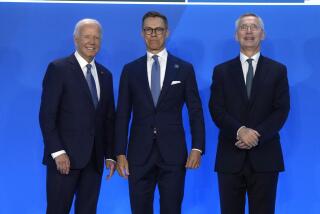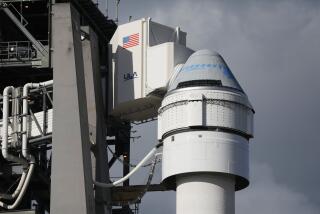American Firm, Soviets Sign Deal to Launch Satellites
- Share via
HOUSTON — The Soviet Union and an American company agreed to a $54-million deal Wednesday in which U.S.-made satellites would be launched into orbit with Soviet spacecraft or rockets for the first time.
The agreement remains far from certain, however, because the U.S. government has banned the export of satellites to the Soviet Union.
While not completely ruling out the possibility that the satellites could be exported, one State Department official on Wednesday said it seemed unlikely.
“U.S. policy expressly prohibits launching U.S. satellites on Soviet spacecraft,” he said. “Currently we have no plans to change that policy. I think this company would have a difficult time getting an export license.”
But Art Dula, president of Houston-based Space Commerce Corp., which brokered the deal, said the launches should be allowed because the satellites are so simple and widely used that there would be no vital technology transfer to the Soviets.
The contract, which calls for the launching of up to eight satellites, was signed here Wednesday afternoon by Dmitry Y. Poletayev, director of Glavkosmos, the Soviet civilian space agency, and Jordan Smith, president of Energetics Satellite Corp. of Colorado.
The satellites would be used as part of a so-called “geolocation system,” which would allow customers to track vehicles and their cargo to within a distance of 50 feet.
Smith said Wednesday that signing with the Soviets was based on cost and the availability of American spacecraft. He said the Soviets would charge him an estimated $6 million per launch as a secondary payload, while the U.S. price tag was at least double that. And he said that with so few American launchings, getting one of his satellites even a launch date had proven difficult.
According to William Wirin, executive vice president of Space Commerce Corp., the Soviets reached earth orbit 90 times in 1988, compared to 28 space flights for the rest of the countries--including the United States--with launch capabilities.
Smith also said that there would be no technology transfer because the satellites he makes are only used to relay information and he said the only computer equipment on board is for keeping the small satellite on course.
“It looks like an upside down umbrella,” said Smith. “The system is so simple, there is no technology transfer. The technology comes off the shelf.”
But technology is not the only question. There is much concern in the United States that if American businesses used subsidized Soviet flights, the commercial launching industry in this country, now in its infancy, would be in serious trouble.
Smith said that if the U.S. government does not allow the export of the satellites to the Soviet Union, he would consider building identical models in another country and putting them in orbit aboard Soviet spacecraft. He said he had no reservations about using the Soviets for his project.
“The world is becoming a free trade global thing,” he said. “I don’t see any difference in going with them.”
But he also said he did not anticipate easily convincing the State Department to let him use the Soviet launch vehicles.
“I think there will be some resistance,” he said. Dula said efforts to obtain the necessary export permits would begin in several weeks.
Should the agreement be approved, the first launch could take place by the end of 1990 from the Biakonur Cosmodrome in the central Soviet Union.
More to Read
Sign up for Essential California
The most important California stories and recommendations in your inbox every morning.
You may occasionally receive promotional content from the Los Angeles Times.













